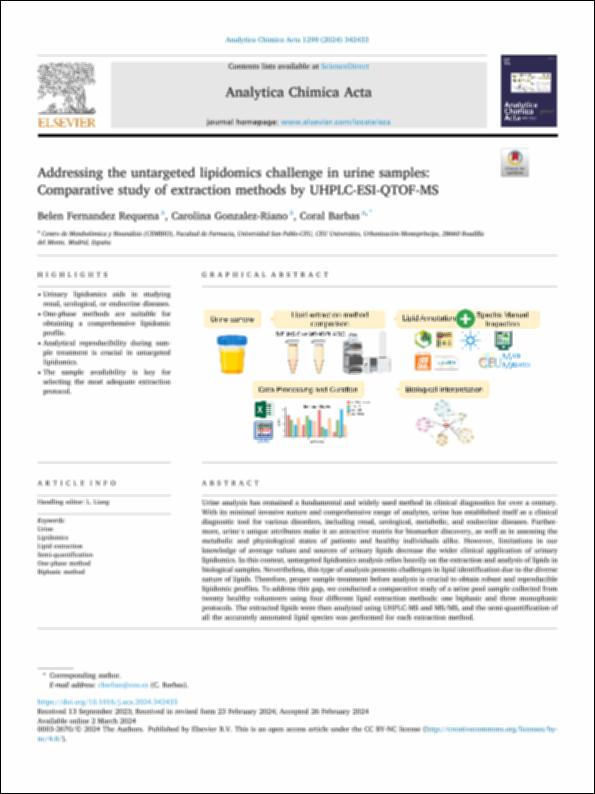Please use this identifier to cite or link to this item:
http://hdl.handle.net/10637/15620Addressing the untargeted lipidomics challenge in urine samples: Comparative study of extraction methods by UHPLC-ESI-QTOF-MS
| Title: | Addressing the untargeted lipidomics challenge in urine samples: Comparative study of extraction methods by UHPLC-ESI-QTOF-MS |
| Authors : | Fernández Requena, Belén González Riaño, Carolina Barbas Arribas, Coral. |
| Keywords: | Urine; Lipidomics; Lipid extraction; Semi-quantification; One-phase method; Biphasic method |
| Publisher: | Elsevier |
| Citation: | Belen Fernandez Requena, Carolina Gonzalez-Riano, Coral Barbas, Addressing the untargeted lipidomics challenge in urine samples: Comparative study of extraction methods by UHPLC-ESI-QTOF-MS, Analytica Chimica Acta, Volume 1299, 2024, 342433, ISSN 0003-2670, https://doi.org/10.1016/j.aca.2024.342433 |
| Abstract: | Urine analysis has remained a fundamental and widely used method in clinical diagnostics for over a century. With its minimal invasive nature and comprehensive range of analytes, urine has established itself as a clinical diagnostic tool for various disorders, including renal, urological, metabolic, and endocrine diseases. Furthermore, urine’s unique attributes make it an attractive matrix for biomarker discovery, as well as in assessing the metabolic and physiological states of patients and healthy individuals alike. However, limitations in our knowledge of average values and sources of urinary lipids decrease the wider clinical application of urinary lipidomics. In this context, untargeted lipidomics analysis relies heavily on the extraction and analysis of lipids in biological samples. Nevertheless, this type of analysis presents challenges in lipid identification due to the diverse nature of lipids. Therefore, proper sample treatment before analysis is crucial to obtain robust and reproducible lipidomic profiles. To address this gap, we conducted a comparative study of a urine pool sample collected from twenty healthy volunteers using four different lipid extraction methods: one biphasic and three monophasic protocols. The extracted lipids were then analyzed using UHPLC-MS and MS/MS, and the semi-quantification of all the accurately annotated lipid species was performed for each extraction method. |
| URI: | http://hdl.handle.net/10637/15620 |
| Rights : | http://creativecommons.org/licenses/by-nc-nd/4.0/deed.es OpenAccess |
| ISSN: | 0003-2670 |
| Supported by: | Acuerdo Transformativo - 2024 |
| Issue Date: | 2-Mar-2024 |
| Center : | Universidad San Pablo-CEU |
| Appears in Collections: | Facultad de Farmacia |
Items in DSpace are protected by copyright, with all rights reserved, unless otherwise indicated.


